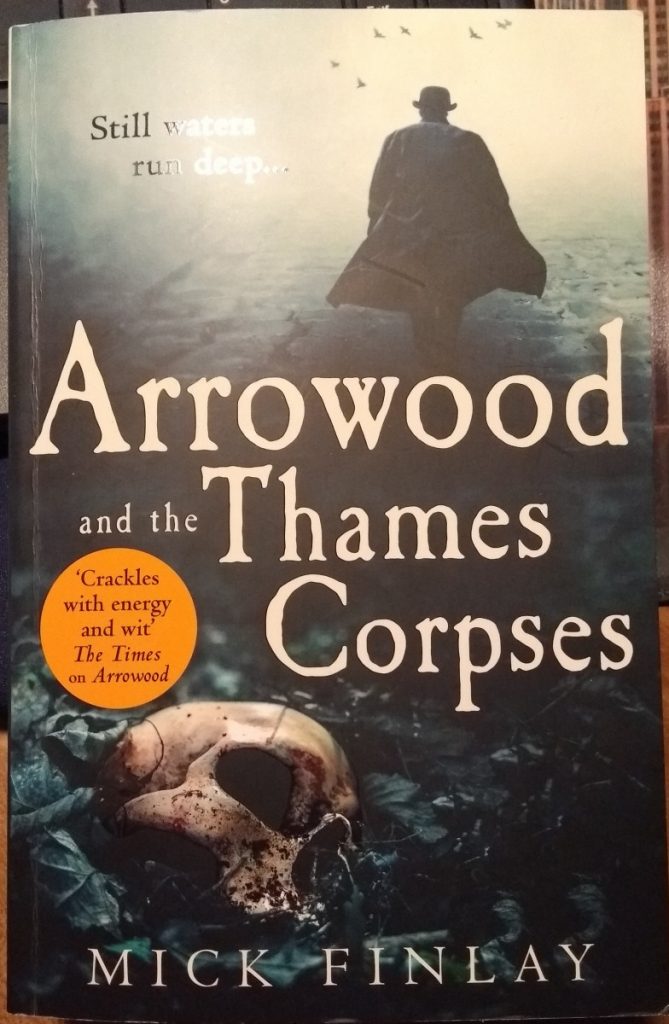Book Review: Mick Finlay’s “Arrowood and the Thames Corpses”
The third volume in the Arrowood series, after Arrowood and The Murder Pit, is set in the summer of 1896. It is seethingly hot and journalist turned private detective William Arrowood is out of money due to a lack of paying jobs. The events are told by Arrowood’s companion and occasional strongman, Norman Barnett, and once more we delve into the grimy and violent London south of the river. The case involves the captain of a small pleasure steamer and his teenage daughter, who fear that a rivalling family is trying to put them out of business, possibly going to such lengths as setting fire to the boat. Arrowood is hopeful that he can solve the case and earn some much needed money, but it soon becomes clear that the case is much more intricate and dangerous than he had hoped. When the skulls of children and three corpses are found attached to the boat, the investigation becomes a question of life and death, taking Arrowood and Barnett into dangerous territory which almost costs Barnett’s life.
I won’t say more about the case, because, for obvious reasons, that would take the pleasure out of reading the book, but let’s dwell with the characters a little. Over the last two books, Finlay has allowed his characters to grow, and even though it is possible to read this book independently of the first two as sufficient background information is provided when characters from former stories appear, it does tie in nicely with its prequels. The relationship between Arrowood and Barnett is still a complicated one – Barnett is hyperaware of the flaws in the guvnor, as, undoubtedly, is Arrowood of those in Barnett. Through the sidekick’s narrative perspective, we once again get a graphic description of the event and the people involved, including his lacklustre fling with a girl who has attached herself to him, and his complicated love for Ettie Arrowood, whose return to London with a mystery baby irks him, but even more so her brother, to no end. But it is the description of events, the explicit depiction of violence, poverty and depravity, which make this series stand out in such stark contrast to the Sherlock Holmes stories, which are repeatedly derided by Arrowood. As in the previous novels, he has very little love for the master detective, yet his poor opinion of him is always tinged with jealously and grudging respect – not for the work he is doing, but for being able to live off it. There are several rather hilarious references to Holmes in the book, and he is even part of the mystery this time, if only marginally.
As with the last two books, this one is not for the faint-hearted, but it is beautifully written, with a mystery that is fast paced and complicated, with more than a few gut punches (literal ones for the characters and metaphorical ones for the reader). Once more, I found myself worrying a lot for the characters who are so deeply flawed and oh so human.
Closing the book, you taste the soot of London on your lips and you feel as if you closed a door on old friends, whom you hope to see again soon, but you know that when you do, they will have witnessed more horrors and carry a few more scars.
The book was published with HQ, and imprint of HarperCollins on April 2, 2020.
Right now, it is important to support smaller businesses, especially book shops. Ask, if your local bookshop will ship the book to you!

Maria teaches English Literature at Leipzig University, Germany, published a German introduction to Sherlock Holmes and is a fan of all things Holmes – but especially of the Canon stories and Sherlock BBC. Contact her at @stuffasdreams

Thanks for the review, this caught my eye:
the explicit depiction of violence, poverty and depravity, which make this series stand out in such stark contrast to the Sherlock Holmes stories.
Probably not the site to say it on, but I do find the original Holmes novels a little sanitised, so maybe this is the book for me.